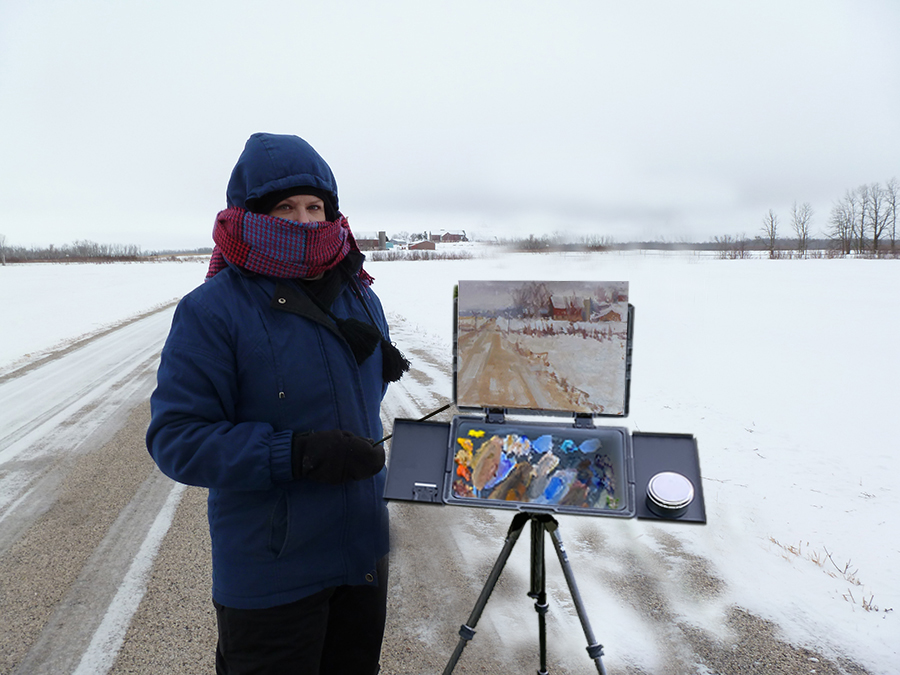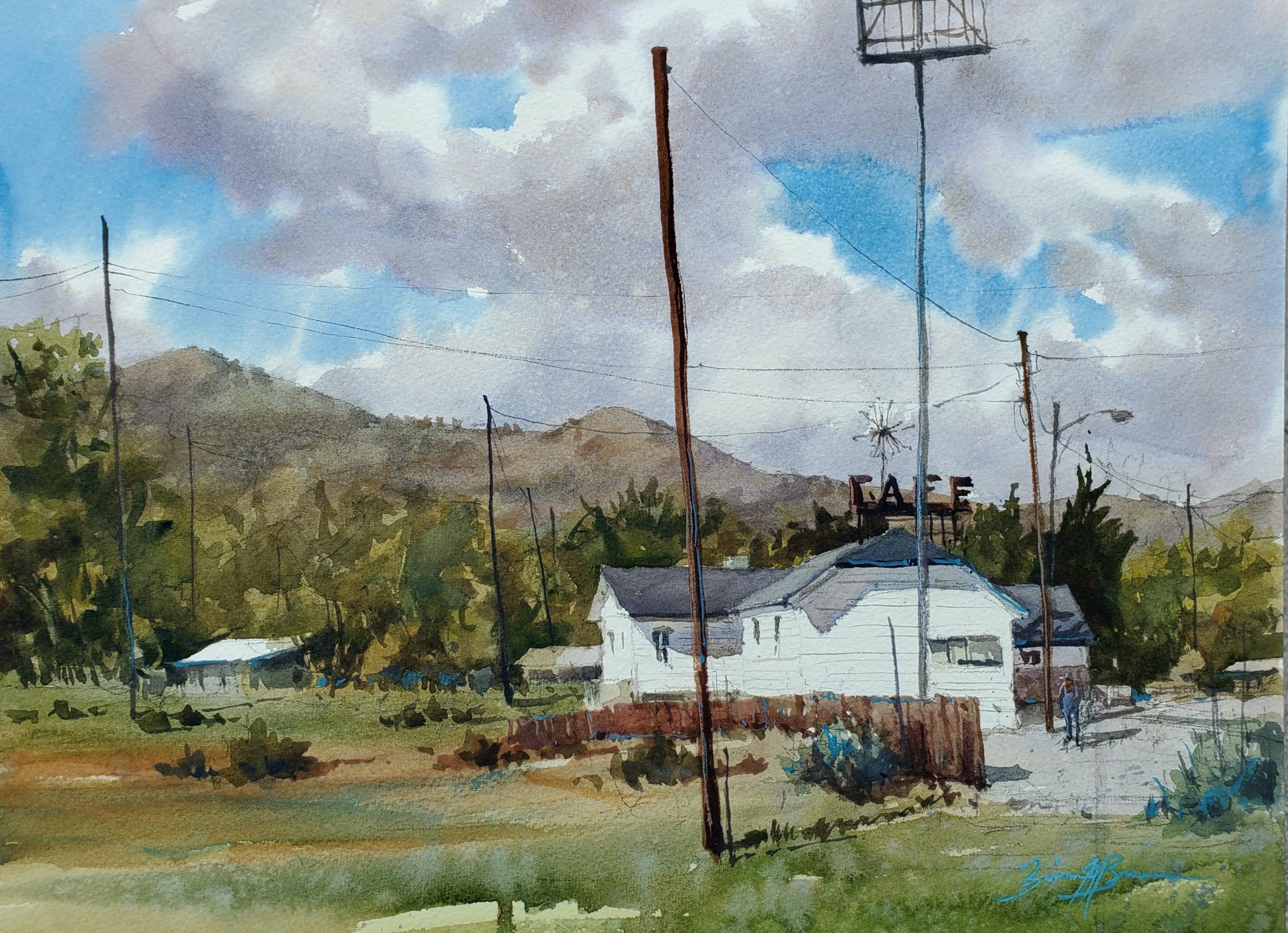You might think you know all the tricks to the trade when it comes to painting en plein air, but these four artists have some witty ideas for making it an even better experience.
Lyn Boyer:
1. I absolutely don’t wear gloves to paint. Remember finger painting and how you could actually feel the surface and the paint as you moved it? For me, my hands are essential tools for painting. Thumb, fingers, side of my hand, fingernails. There are times when I want to soften an edge, scratch a mark or radically move a passage of paint by sliding the side of my hand across it. I can’t make those marks or move the paint the way I want without being able to feel exactly what I’m doing. Before you panic about safety, I always use Gloves in a Bottle before beginning a painting session to create a barrier between my skin and the pigments and solvents.
2. Rather than always picking up a traditional tool and being content with the predictable mark it may make, I will instead decide ahead of time what kind of marks I want to make and what I want them to look like. If my standard tool-set can’t do that I’ll go looking for something that will. It could be a stick, a rock, feather, some twine, a barbecue skewer or something else from the kitchen drawer. Once I’ve pillaged a piece of kitchen equipment to use for painting – it stays permanently in the studio. No matter how clean I get it afterwards the thought of mixing a bowl of cookie dough with something I’d dipped in some cadmium red just doesn’t work for me.
3. One problem I’ve faced, particularly out west where you often have sunlight bouncing off sand, is the bright light from the ground bouncing back at you while you’re trying to paint. The intensity of the light shuts down your retinas, letting in less light and making it more difficult to properly see correct values and colors. I took to carrying the auto sunshield from my car and a couple of large binder clips. The sunshield pancakes down into a small circle that fits in my pack but when unfolded is large enough to clip behind and below my panel to block the light bouncing off the ground. You can see better, your eyes are less tired at the end of the day, and it lessens the amount of UV exposure your eyes are getting.

Lori Putnam:
4. When I am painting outdoors, I want to have shade on both my painting and on my mixing palette. Oftentimes I will paint with my back turned to the scene and just turn for quick glances at it as I paint. This actually helps keep my paintings fresh and loose! You can’t paint detail if you are not looking at it.
5. If I am painting in super cold weather, I place Hot Hands underneath my painting palette to keep the oil paint nice and pliable. Of course I also place them several places on my body to keep me warm.
6. There’s something about not knowing being able to see what may be squirming around my feet that is distracting. If traveling to paint by car, I keep a picnic blanket in the back and put it on the ground in tall grass.
John Hughes:
7. There are times when painting outdoors, that the sun is so intense, the glare is overwhelming. This situation usually happens on bright sunny days when painting in snow, or on sandy beaches. Wearing a good hat with a brim that shades my eyes is the first line of defense, but it is often not enough, due to the fact that the sun bounces off of those reflective surfaces and comes at you from all directions. That is why some years ago I decided to buy a pair of fit-over fishing sunglasses, and pop the front lenses out so that I can still turn my canvas into the shade and paint like normal. The beauty of fit -overs is that they block out most of the light coming from the ground, along with the light entering from the sides and from the sky. This method, in conjunction with my hat, usually makes it possible for me to get the job done without the eye strain.
The only drawback is that you literally look like a dork! So, if you absolutely want to look stylish while painting you can try option 2, which is… don’t pop out lenses and paint with your canvas in direct sunlight. I’ve worked both ways and have usually managed to pull it off successfully each time. I think the jury is still out on which method works best, since I only have to do this once or twice a year. Give it a try and see what you think!
Brienne Brown:
8. My car is a plein air tool… I have used it several times to dry my watercolors on humid days. Humidity can make it impossible for watercolor to dry. On these days, I get in my car and turn on the heater full blast, even in the summer. This way I can take my painting to the next stage.
9. I have a small bottle of vodka that I pack in my plein air bag during the winter. Adding alcohol to my water and spray bottle helps my watercolors from freezing. Vodka seems to work the best, though I have used white wine and that works too. 😊 No, I don’t drink it…though you could.
10. I add a wad of paper towels in my apron front, right pocket. Then as I paint, this is where I dip my brush to take off excess water. This saves my hand from getting too wet and covered with paint. However, I miss a lot and it can drip down my leg. Oh well… I never used to wear an apron while painting because I didn’t really care too much if paint got on my clothes. However, when I realized they had pockets… that was an epiphany.

What’s your favorite “trick” for painting en plein air? Share it with us in the comments below!




Drying watercolour
I use (carefully) a Chefs Bunsen flame torch waved about 3” above the paper
Works well for me.
When I paint in the winter, I put grocery bags on over my gloved hands… keeps me from getting paint all over my gloves. I’d ruined way too many pairs of gloves before I started doing this!
If you can’t finish one up PleinAir, instead of working from photos later, try taking a video instead it provides you with a wealth of information, keeps you from zooming in to your photos for more detail. Keeps it truer to the PleinAir experience.